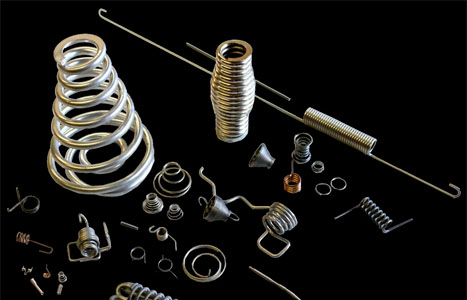
Tension springs are coil springs that bear axial tension. Tension springs are generally made of circular cross-section materials. When not under load, the coils of the tension spring are generally tight and there is no gap between them. Many different terminal devices or "hooks" are used to secure the source of tension for a tension spring. Tension springs work on the opposite principle to compression springs. Compression springs work in reverse when compressed, and tension springs work in reverse when stretched or pulled apart. When the ends of a stretch spring are pulled apart, the spring attempts to pull them back together. Like compression springs, tension springs also absorb and store energy. But unlike compression springs, most tension springs are usually under some degree of tension, even without any load. This initial tension determines how tightly the tension spring coils without any load. Mainly used in medical respiratory equipment, motion control, medical mobile equipment, hand tools, home care equipment, shock absorption, pump springs, mechanical and electronic protective hardware, fluid control valves, mechanical aerospace components, actuators, and switch equipment.
Compression springs are coil springs that bear axial pressure. The cross-sections of the materials used are mostly circular, and they are also made of rectangular and multi-strand steel coils. The springs are generally of equal pitch. The shapes of compression springs are: cylindrical, conical There is a certain gap between the coils of the compression spring, such as medium convex and concave shapes, as well as a small amount of non-circular shapes. When subjected to external loads, the spring shrinks and deforms to store deformation energy. Compression springs provide resistance to external load pressure. Compression springs are generally made of metal wire coiled at equal pitches and have a fixed wire diameter. Compression springs use multiple open coils to provide resistance to external pressure (such as gravity pressing down on a wheel, or the body pressing on a mattress). That is, they push back against external pressure. Compression springs are generally made of metal wire coiled at equal pitches and have a fixed wire diameter. Mainly used in medical respiratory equipment, medical mobile equipment, hand tools, home care equipment, shock absorption, engine valve springs, torsion spring is a mechanical part that uses elasticity to work.
Generally made of spring steel. It is used to control the movement of parts, mitigate impact or vibration, store energy, measure force, etc. It is widely used in computers, electronics, home appliances, cameras, instruments, doors, motorcycles, harvesters, automobiles, and other industries!


 +852-24221123
+852-24221123
 E-mail
E-mail
